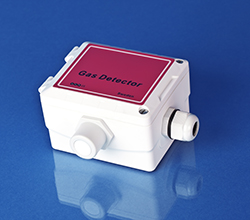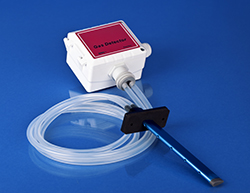|
|
|
GAS DETECTION - HYDROCHLORIC ACID (HCl) |
|
 |
|
|
|
|
|
Hydrochloric acid, HCl
Hydrochloric acid is a colourless, corrosive gas with a pungent
odour.
Hydrochloric acid is soluble in water and the solution is called
hydrochloric acid, this may be important to think about when the
leaking gas can result in corrosive concentrations of hydrochloric
acid, if it comes into contact with water.
HCL is obtained as a byproduct in the chemical industry and used in
particular in the semiconductor industry.
Hydrochloric acid is highly irritating to the eyes and mucous
membranes.
Odour threshold limit value is about 5 ppm.
If the concentration increases up to about 100 ppm it may give rise
to very serious pain.
Very high concentrations are associated with mortal danger.
Important to note is that the fact that symptoms may arise much
later.
Persons who have been exposed to HCl
should see their doctor immediately.
Threshold limit value for max. gas concentration is 5 ppm
Alarm limit should be set at the upper limit value.
Because the gas is readily absorbed by materials in the pipelines
etc., the use of aspiratory systems may be problematic.
Sensor Placement
Hydrochloric acid is slightly heavier than air which means that the
detectors should in most cases be placed low, since the gas will
sink to the floor.
In some cases, however, you cannot trust this fact.
Explosion Risk
Hydrochloric acid can, together with certain other substances to
cause explosions.
Examples of such substances are ammonia, ethylene oxide, and others.
References |

IP 65,
Wall design |
|
|
|

IP65,
Duct design |
|
|
|
|
ATEX Gas detectors are available for 2
explosion classes as follows:
Zone 1 is available with or without display .
Gas detectors for ATEX Zone 1 are located in a flameproof enclosure,
EEx d
The shell is such that ignition and
combustion within the shell of a potential explosive gas mixture is
not propagated to the explosive mixture outside the enclosure and
the enclosure can thus endure the resulting explosion pressure
without damage.
In Zone 1 ,
one can expect an explosive atmosphere to occur during normal
operation but the presence of it is relatively
short.
The equipment shall not be a source of
ignition in normal operation or when an error occurs.
Gas detectors for ATEX Zone 2 are of the
design Non-sparking EEx nA
EEx nA is a non-sparking piece
equipment.
In Zone 2, you need not count with an
explosive atmosphere to occur during normal operation, and if it
should occur, which is probably rare it is of
short duration.
The equipment shall not be a source of
ignition during normal operation.
|
|
|
|
|
|